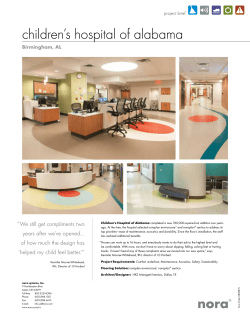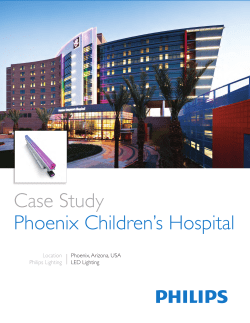
Space Planning with Lifecycle Financial Science & Technology
Science & Technology Space Planning with Lifecycle Financial Decision Making- How to Make it Happen SPACE STRATEGIES 2013 / HYATT REGENCY SCOTTSDALE, ARIZONA Copyright UTMB Health & HKS, Inc. 2013 1 Welcome and Introductions Kim McKay, AIA University of Texas Medical Branch Assistant Vice President Facilities Portfolio Management Dave McGlashan, RA HKS Science & Technology Vice President Senior Science Architect Kenneth DeBoer, NCARB HKS - Earl Walls Associates Vice President Senior Laboratory Planner Copyright UTMB Health & HKS, Inc. 2013 2 Agenda Decisions Have Consequences – the case for Lifecycle-Based Decision Making Space Allocation Challenges Institutional Vision and Space Management Data Management Case Studies Copyright UTMB Health & HKS, Inc. 2013 3 Decisions Have Consequences Cheaper is Seldom Less Expensive Typical Costs for New Projects over the First 10 Years of Operations: Planning and Design Costs Construction Costs Utility / Energy Costs Operational Costs Total 1% 11% 17% 71% 100% Space costs a lot to construct, but much more to operate and maintain Beware the term “Value Engineering” during Construction Cheaper Building Systems and Materials leads to Higher Maintenance and Operational Costs Consider Lifecycle Costs before making decisions during construction Copyright UTMB Health & HKS, Inc. 2013 4 Decisions Have Consequences Copyright UTMB Health & HKS, Inc. 2013 5 Lifecycle-Based Decision Making Focus on the Big Picture: People and Politics Change QUESTION: At how many of your organizations are Facilities Design & Construction, Maintenance / Operations and Utilities / Energy Costs all different departmental budgets? RESULT: FD&C - Spend little as possible on projects, save capital for other projects Maint / Ops – More robust quality to save Maint & Ops budget spend Accounting just pays the bills and logs spend for each department Departments only concerned with their own responsibilities SOLUTION: All departments work together toward a common goal connected to the Institutional Vision. Be Collaborative and Inclusive. Copyright UTMB Health & HKS, Inc. 2013 6 Lifecycle-Based Decision Making Focus on the Big Picture: People and Politics Change How might things be different under these two scenarios? A. Longstanding Leadership planning to retire over next few years… B. New Leadership planning to make a name for themselves… Faculty and Curriculum also change over time New ground-breaking researcher requires $10M Custom Lab fit up New Faculty requires oversized office “The Squeaky Wheel gets the oil”… approval of projects to silence those who complain the loudest “Full Moon Syndrome”… crazy requests Decision Making should be based on priorities and contribution to Vision Copyright UTMB Health & HKS, Inc. 2013 7 “I need a bigger office.” Copyright UTMB Health & HKS, Inc. 2013 8 “I need more storage space.” Copyright UTMB Health & HKS, Inc. 2013 9 Space Allocation Challenges Dealing with “Space Hoarders” PROBLEM: Shell space or other underutilized areas loaded with old furniture, equipment, supplies, departmental records… things not in use, but not yet decommissioned or discarded SOLUTION: 1. Identify what belongs to whom 2. Conduct a meeting with representatives from each affected department 3. Establish categories for everything in the space Things that can be sold, consigned or returned to vendor for credit Things that can be donated or have enough value to be hauled off for free Files that could be stored offsite, or are old enough to be destroyed Things that have no value and should be discarded 4. Establish a deadline for each department to take action on their items- and tell everyone you will have everything remaining hauled off on deadline date 5. Call Waste Removal Service to haul everything that remains on deadline date Copyright UTMB Health & HKS, Inc. 2013 10 Space Allocation Challenges Dealing with “Squatters” PROBLEMS: People occupying offices that belong in cubicles Departments making unauthorized moves into unoccupied spaces Departments “claiming” rights to “their” space… “that room was always ours.” SOLUTIONS: “NIP IT IN THE BUD” The longer people are allowed to occupy space that they shouldn’t be in… the harder it is to remove them. Establish Space Standards and Policies where none exist already, and adhere to them as closely and as quickly as possible Spread the Word… “Space” is an asset that belongs to the Institution or Organization, not to the person or department that claims it first Copyright UTMB Health & HKS, Inc. 2013 11 Decisions Have Consequences Should we build new or renovate existing? What are initial vs. long-term costs? How well will the building function? How much longer should we keep using this building? At what point does it become a “money pit”? Is the structure sound enough to renovate? Should we own or lease? How long do you plan to be there? What is your cash flow? Informed Space Decisions require a Solid Foundation Projects must advance an organization toward strategic goals Take everything into account… initial and long term costs / considerations Benchmarks, standards and policy make space decisions easier to manage Copyright UTMB Health & HKS, Inc. 2013 12 Institutional Vision Space Standards, Policies and Benchmarks Tie space management to strategic plan, mission and vision of organization Policy is basic foundation for all work with space management Executive buy-in is important Space standards are imperative to move toward equitable space assignment Benchmarks are important in establishing guidelines and standards Copyright UTMB Health & HKS, Inc. 2013 13 Translating Mountains of Data into Useful Information Space Standards based on Benchmarks Research - $300 direct expense/ assignable square foot Academic – (Texas Higher Education Coordinating Board) 50 sf/student Healthcare – varies, based on modalities Office Space – Facilities Steering Committee-Approved standards for space Translating Mountains of Data Into Useful Information The Annual Process: Conduct Annual Space Survey Prepare Annual Space Report Conduct Space Assessments Compare to Metrics/Targets Conduct Gap Analysis Determine Space Utilization Determine Facility Condition Develop Action Plan Develop Capital Requests Make Policy Adjustments Start again 15 Copyright UTMB Health & HKS, Inc. 2013 15 Translating Mountains of Data Into Useful Information Positive % in the gap indicates excess space Facilities Business Operations Operations and and Facilities Business Excess space above 10% of model Space constrained below 10% of model GAP ANALYSIS - SUMMARY DRAFT DIVISION CODE CODE DIVISION A B C=A-B ACTUAL AREA asf CURRENT MODEL ∆ ACTUAL AREA - % Gap - Current BASED ON CURRENT MODEL Area compared to BENCHMARKS model DIVISION NAME DIVISION NAME D FORECASTED MODEL: ESTIMATED GROWTH NEXT 5 YRS E=C-D *GAP ∆ For future Based on dept. projections % GAP current and forecasted area compared to model RESEARCH AND ACADEMIC RESEARCH AND ACADEMIC 220.143600 220.143600 220.xxxxxx 230.146400 230.146400 230.xxxxxx 220.143800 220.143800 220.xxxxxx 220.144400 220.144400 220.xxxxxx 220.145100 220.xxxxxx 220.145100 220.xxxxxx 220.144500 220.144500 MEDICINE INTERNAL MEDICINE INTERNAL DEPARTMENT 1 PHARMACOLOGY PHARMACOLOGY DEPARTMENT 2 NEUROLOGY NEUROLOGY DEPARTMENT 3 PATHOLOGY4 PATHOLOGY DEPARTMENT SURGERY 5 DEPARTMENT SURGERY DEPARTMENT PEDIATRICS6 PEDIATRICS 106,171 21,324 12,351 112,051 52,427 51,730 79,245 12,716 10,345 136,960 32,661 45,893 26,926 8,608 2,006 (24,909) 19,766 5,837 25% 40% 16% -22% 38% 11% 7,700 0 1,200 6,370 1,782 1,140 19,226 8,608 806 (31,279) 17,984 4,697 Actual Area as coded in‘GAP’ between current space Forecasted 5 yr. space need based on Archibus occupied and the benchmark department projections model Current Space model based on Benchmarks 18% 40% 7% -28% 34% 9% % of GAP compared to current area ‘GAP’ as a percent of ‘GAP’ in the future with actual current space current excess or constrained space Positive % in the gap indicates excess space Excess space above 10% of model Space constrained below 10% of model Copyright UTMB Health & HKS, Inc. 2013 16 Institutional Vision and Space Management Hurricane Ike Over 1.2 million square feet of campus damaged Some space will never be returned to service Logical policy for ground floor usage Recovery After the Disaster Must have a plan Business Continuity primary focus Establish method for people to return to space Establish process and priority for moves For the Future of UTMB Develop policies and emergency actions plans Be defenders of policy – HOLD FAST Copyright UTMB Health & HKS, Inc. 2013 17 Case Studies No two are alike…. Science Disciplines of Science Science Sector Form of Governance Copyright UTMB Health & HKS, Inc. 2013 Kuwait University College of Science Separation of sexes DEA Regional Testing Labs Laundry University of Nevada Las Vegas Themes & teams Science, engineering and art 18 Case Studies Remain Connected with the Plan Have a Strategic Plan for Science Clear Long Term Direction Framework for Decisions Foundation for Operational Planning Basis for Accountability Stimulus for Change Explain the Business to Others Welcome Trust Centre for Human Genetics – Oxford University The big idea University of Texas Arlington Tier 1 Research Institution Targeted preeminence Copyright UTMB Health & HKS, Inc. 2013 19 Case Studies Evolution with PEST Environments Target preeminence Narrowly defined themes Multidisciplinary programs Institutional strengths Support regional economic growth Fit with potential partners Align with National Science Roadmaps Greater motivation to partner State funding streams Grant funding challenges Private sector pipelines Greater focus on development Tech transfer Tech capitalization Copyright UTMB Health & HKS, Inc. 2013 20 Case Studies Hybrid Multidisciplinary Models Private Sector Project team adaptability Entrepreneurial Regulatory environments Academic Sector Cultural shifts Governance Tenure tracking Entrepreneurial human resource Translational r&D Tech transfer and capitalization Regulatory environments External partners Copyright UTMB Health & HKS, Inc. 2013 21 Case Studies New Drug Development Preclinical Drug Candidate Evaluation Drug Discovery • Drug Targeting • Formulation • Preliminary Animal Strong Institutional Competency Copyright UTMB Health & HKS, Inc. 2013 IND Submittal Package IND Submission • Physiology and Target Development • Candidate Selection & Optimization • Pre-Clinical Efficacy & Toxicology • Formulation & Delivery • IND Application – FDA Submittal Limited Institutional Competency Real Opportunity Human Clinical Trials Clinical Trials • Phase I Clinical Trials • Limited Human Trials • Phase IIa Clinical Trials • Continuous - Evaluation • Human Trial Population (100 – 300) • Phase IIb Clinical Trials • Continuous Evaluation & Pilot Plant Inspection • Human Trial Population (300 – 500) • Phase III Clinical Trials • Continuous Evaluation • Pilot Plant Inspection • Human Trial Population (500 – Thousands) No Institutional Competency 22 Summary What you should take away from this Session: Buildings cost MUCH more to Operate and Maintain than to Construct Focus on the “Big Picture”… link decisions to Institutional Vision, Strategic Goals and Objectives Data Management is essential… Develop the right Systems and Processes for your organization Decisions have Consequences… you live with them for a long time Copyright UTMB Health & HKS, Inc. 2013 23 Thank You! Kim McKay, AIA University of Texas Medical Branch Assistant Vice President Facilities Portfolio Management Dave McGlashan, RA HKS Science & Technology Vice President Senior Science Architect Kenneth DeBoer, NCARB Copyright UTMB Health & HKS, Inc. 2013 HKS Earl Walls Associates Vice President Senior Laboratory Planner ktmckay@utmb.edu (409) 772-3551 dmcglashan@hksinc.com (404) 442-7878 kdeboer@hksinc.com (214) 969-5599 24
© Copyright 2025










